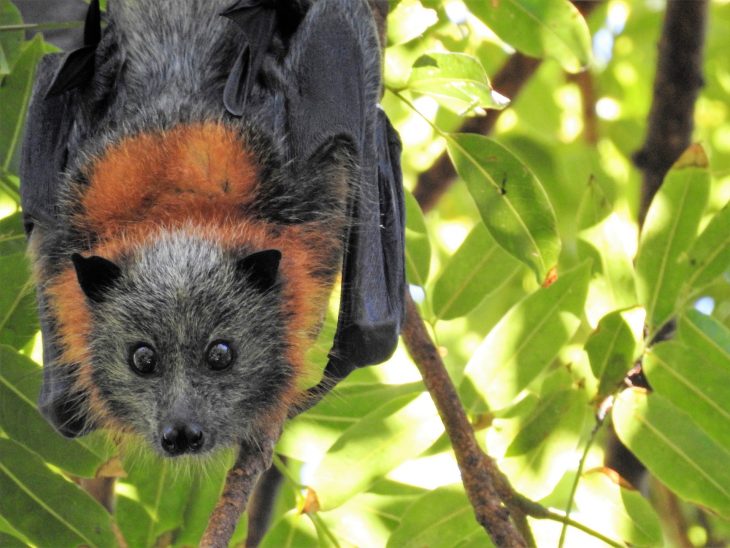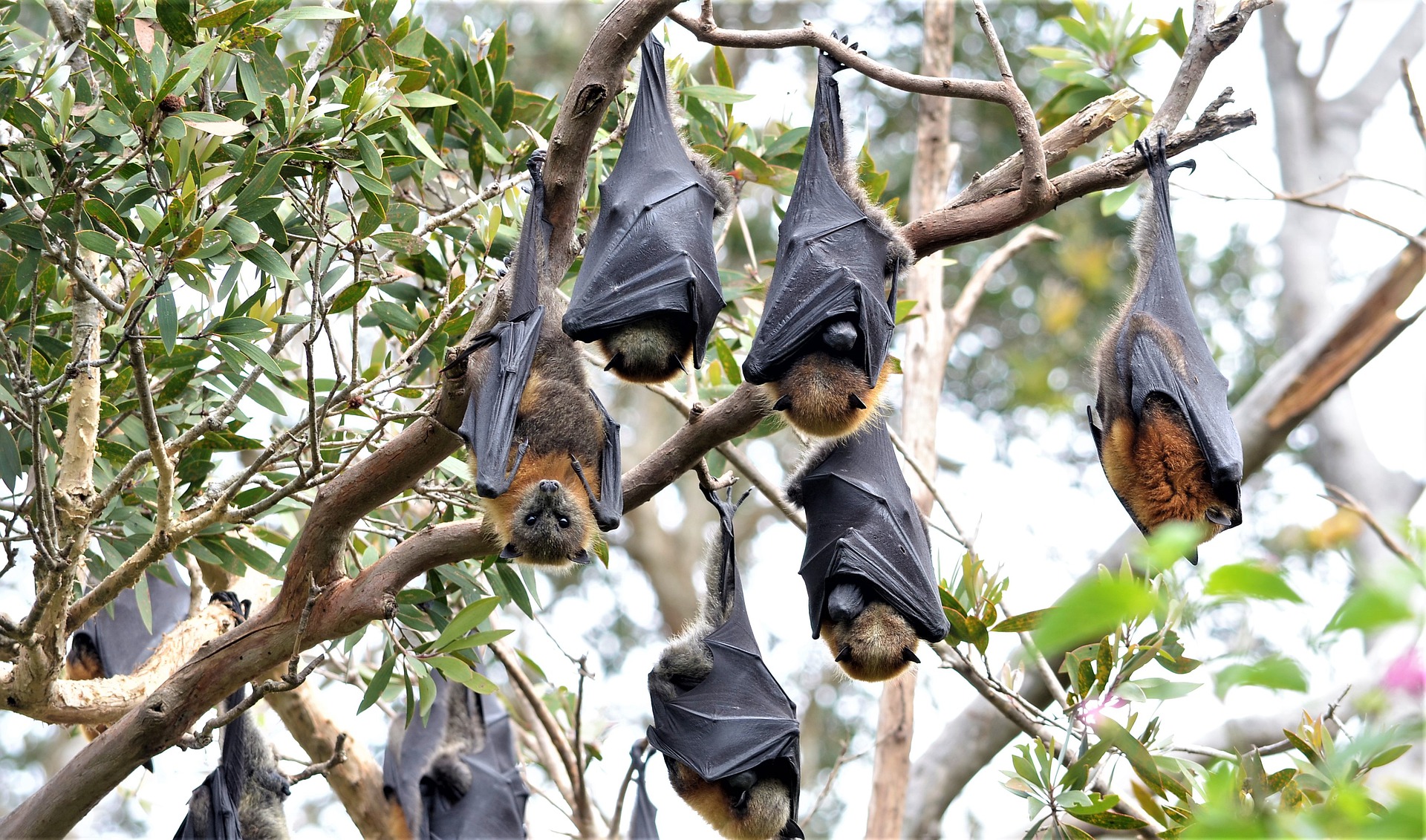
The megabats or fruit bats are a family of large bats native to the tropics of the Old World. This family of bats includes some of the largest bats in the world. Although their size makes them look quite menacing, these herbivorous bats feed mostly on fruits or nectar. This family of bats is often misunderstood, but they play crucial roles in the conservation of nature. Get to know about these majestic animals through these fascinating fruit bat facts.
- The ancestor of all living fruit bats lived around 31 million years ago.
- They likely split off from other bats around 58 million years ago.
- The family Pteropodidae has 197 recorded species of fruit bat as of 2018.
- Megabats typically live up to 30 years both in the wild and in captivity.
- These large bats mostly give birth to one offspring at a time.
- Fruit bats are mostly active at night or at twilight, but some species are active during the day.
- Most fruit bats live in tree branches in primary or secondary forests.
- Some megabats also roost by hanging on the walls of caves.
- A few species of fruit bats are migratory.
- Megabats belong to the family Pteropodidae, which is a branch of the order of bats (Chiroptera). They are also part of the suborder Megachiroptera.
- Fruit bats are currently prominent in the tropical and subtropical areas of the Old World, which includes Oceania, Eurasia, and Africa.
- The fruit bat family likely originated from Australasia and spread throughout the Old World.
- Megabats have claws on their thumbs and forefingers. They can use these claws to climb rough edges and gain access to food that’s inaccessible by flight.
- Baby fruit bats cannot fly; they cling to their mothers and feed on their milk. The lactation period typically ranges from 7 weeks to 4 months.
- Their main predators are birds of prey, snakes, large lizards, and humans.
- Of all the 46 fruit bat genera, only bats of the genus Notopteris have tails.
- Some fruit bats, especially in the genera Acerodon and Pteropus, are also referred to as flying foxes. They get their names from their appearance, which has a similarity with foxes.
- Most species of megabat have colors that blend in with their surroundings. When roosting, they resemble dead leaves.
- Fossil records of fruit bats are quite rare, and scientists suggest that around 98% of their fossil history is missing.
- In the genus Dobsonia, the wings of the bats attach near their spines. This gives them the appearance of having furless backs, earning them the name “naked-backed” or “bare-backed” fruit bats.
The megabat family includes the largest bats in the world.
Megabats get their name from their enormous sizes and weights. The largest bat in the world, the giant golden-crowned fruit bat (Acerodon jubatus), belongs to the family of fruit bats. This giant bat has a wingspan of up to 5.5 ft (1.7 m). The megabat family also includes the great flying fox (Pteropus neohibernicus), which is among the heaviest bats in the world, weighing up to 3.5 lb (1.6 kg).
Although the fruit bat family does include a number of enormous bats, not all megabats are larger than the members of other bat families. In fact, the large bats are outliers in size within the megabat family. Many fruit bats are actually quite small, with around 28% of megabat species weighing no more than 1.8 oz (50 g). The smallest megabat species, the spotted-winged fruit bat (Balionycteris maculata), only has a head-to-body length of 2.0 to 2.4 in (5.2 – 6.2 cm) and weighs around 0.46 oz (13 g).
They mostly feed on fruits, nectar, and pollen.

Megabats may often look like the inspiration of many scary stories, but they’re actually gentle giants. These bats are primarily herbivorous, mostly feeding on plant matter. As their name implies, most fruit bats rely on fruits, and some may also feed on the nectar and pollen from flowers. Many species of the megabat genus Pteropus feed mainly on parts of fig plants.
Fruit bats may also consume other parts of the plants such as the flowers, twigs, barks, leaves, and sap, among others. These large bats may feed up to 2.5 times their body weight each night.
Megabats have incredible endurance.
Fruit bats typically fly long distances to forage for food. Flying is a very exhausting and energetically-taxing activity, and fruit bats use up to 20 times more oxygen when they’re in flight compared to their normal oxygen consumption. Human athletes can only sustain this much oxygen consumption for a few minutes, but megabats seem to endure long flights just fine due to their impressive endurance.
Megabats owe this endurance to their huge lung volumes and efficient hearts. Fruit bats have a proportionally higher lung volume compared to mammals and even birds. Their hearts are also fast-pumping, and some species of fruit bat can even reach a maximum heart rate of 728 beats per minute. Truly some of the most impressive fruit bat facts!
Unlike other bats, most fruit bats cannot echolocate.
Because fruit bats feed mainly on fruits and other plant matter, they don’t rely on echolocation to navigate around and catch their meals. Instead, they use their acute sense of sight and smell to forage for food. Some megabat species, however, use crude echolocation to navigate in dark surroundings. The most notable examples of this behavior are the megabats of the genus Rousettus, which live in darker areas deep inside caves.
The males of some fruit bat species can produce milk.
In most mammal species, making milk for babies is solely a mother’s job. For some fruit bats, however, the fathers can also produce milk. The males of some species such as the Bismarck masked flying fox (Pteropus capistratus) and the Dayak fruit bat (Dyacopterus spadiceus) can produce milk with their functional mammary glands. This allows them to assist with the raising and nursing of their young.
This article belongs to Facts.net and may not be reproduced, copied, edited, published, transmitted, or uploaded in any way without the permission of Facts.net.
Pregnant females usually roost with other pregnant females.

Most fruit bats are social animals that tend to sleep together in large roosts. These roosts vary in size, with some having only a few individuals and some involving hundreds of thousands of individual bats. Megabats communicate with each other through scent, vocal signals, as well as body movements to enhance the meaning of the vocal signal. These bats may even have dialects that vary for different colonies.
In many species of fruit bats, pregnant females tend to leave their original flock and form nursery roosts with other pregnant females. In these nursery groups, the pregnant females form their own social network and take care of each other.
They help pollinate flowers and spread the seeds of plants.
Megabats have an important role in their local ecosystem. By feeding on fruits and nectar, the fruit bats help pollinate flowers and disperse the seeds of various plant species. Some plants have developed specific adaptations to help bats gain access to their fruits and flowers. For example, these plants may grow their flowers and fruits at the end of branches to make them more accessible to bats.
Megabats serve as the primary pollinators of many species of plants. Many scientists consider the Madagascan fruit bat (Eidolon dupreanum) as the sole pollinator of the rare baobab tree (Adansonia suarezensis) in Madagascar. Additionally, their feces can serve as nutrient-rich fertilizers for plants.
Fruit bats are important parts of human culture.
Humans and megabats have had a long history, and human cultures and traditions often involve these majestic animals. The Indigenous peoples of Australia feature megabats in their cave art, and they are also prevalent in folktales in Australia and Papua New Guinea. War shields of the Asmat people of Indonesia also feature the wings of flying foxes because these wings supposedly offer protection to the warriors.
Aside from being influential in folk stories and artworks, megabats are popular as tools, bushmeat, and ornamental pieces. Humans use their bones and teeth as necklaces and even barbs for spears. The fur of flying foxes are also valuable for decorating ceremonial axes. In some cultures, products derived from megabats are valuable enough to use as a form of currency.
Fruit bats are hosts to many disease-causing viruses.
As with other families of bats, fruit bats also carry viruses that could potentially infect and cause various diseases to humans and other animals. Various species of megabats carry the viruses that cause Marburg virus disease, Ebola virus disease, and rabies. The bats may pass these diseases on through their droppings, being eaten, and having other forms of contact with humans and other animals. Scientists have not found evidence that megabats carry any coronaviruses.
Many fruit bat species face the threat of extinction.
The family of megabats is quite diverse, and various species differ regarding their conservation status. However, as of 2014, around ¼ of fruit bat species face the threat of extinction due to various factors, according to the International Union for Conservation of Nature (IUCN).
The primary threat to megabat species seems to be human activity. In addition to hunting fruit bats for tools, meat, and medicinal uses, humans also kill them because of the notion that megabats pose threats to their crops, especially fruits. Growing urban areas also result in deforestation, which can significantly limit fruit bat habitats and lower their food supply. Human activity has driven off some megabat species and subspecies to extinction, such as the small Mauritian flying fox (Pteropus subniger) and the Panay golden-crowned flying fox (Acerodon jubatus lucifer). Many government and non-government organizations now make efforts to conserve threatened species, keeping a balance between sustainable hunting and their cultural significance as currency.
Aside from human factors, climate change and other environmental events also negatively impact megabat populations, especially because females and young megabats are more susceptible to extreme temperatures. Typhoons and rising sea levels can have significant impacts on species that are endemic to certain areas. Most notably, in 1979, a typhoon in Rodrigues island of the Republic of Mauritius killed off around half of the population of the Rodrigues flying fox (Pteropus rodricensis). Volcanic activity can also endanger these large bats because many of them reside within the Pacific Ring of Fire.
Was this page helpful?
Our commitment to delivering trustworthy and engaging content is at the heart of what we do. Each fact on our site is contributed by real users like you, bringing a wealth of diverse insights and information. To ensure the highest standards of accuracy and reliability, our dedicated editors meticulously review each submission. This process guarantees that the facts we share are not only fascinating but also credible. Trust in our commitment to quality and authenticity as you explore and learn with us.


